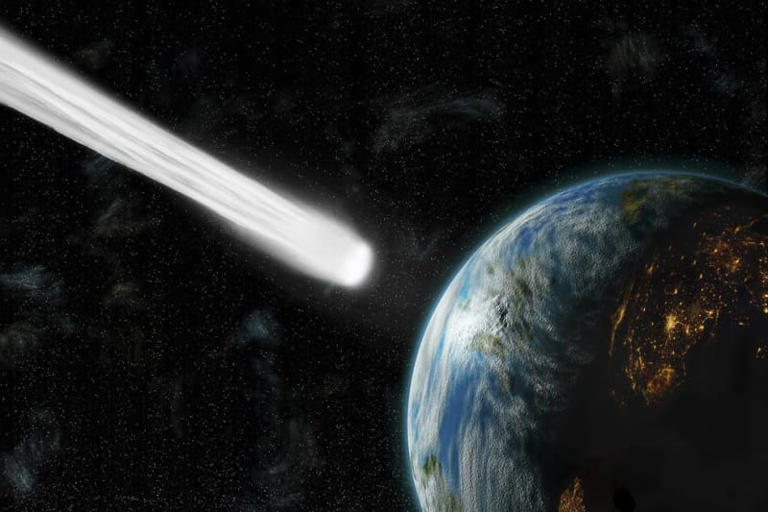Stadium-Sized Asteroid 2024 ON Approaching Earth on Tuesday. The massive space rock will make a close approach but poses no immediate threat. Learn more about its journey and the celestial events coinciding with its approach.

Stadium-Sized Asteroid 2024 ON Approaching Earth
NASA has recently issued an alert for an asteroid of significant size, identified as 2024 ON, which is set to make a close pass by Earth on Tuesday. This asteroid, with a diameter of around 290 meters (950 feet), is roughly the size of a large stadium, making it one of the largest near-Earth objects tracked by scientists this year.
While its approach has captured public attention, there’s no need for immediate concern. According to NASA’s Jet Propulsion Laboratory, 2024 ON will come within approximately 1 million kilometers of Earth. Although this distance may seem close by astronomical standards, it’s still around 2.6 times the average distance between Earth and the Moon. Therefore, the asteroid poses no immediate threat to our planet, though any small deviation in its path could have serious consequences.
Tracking the Path of 2024 ON
Stadium-Sized Asteroid 2024 ON Approaching Earth has been monitored closely by NASA’s Near-Earth Object (NEO) Observations Program. The program, which uses observatories around the world, aims to detect, track, and monitor any objects that could potentially come into contact with Earth.
2024 ON was first discovered by this program, and its last recorded approach to Earth took place in 2013. It is expected to make another pass in 2035, but for now, all eyes are on its 2024 journey. The asteroid is traveling at a remarkable speed of 40,000 kilometers per hour, which is typical for such space objects. Due to its size and speed, the asteroid has been classified as “potentially hazardous” by the Virtual Telescope Project, which recently captured images of it as it hurtled through space.
However, despite its massive size — 2024 ON is 99% larger than most near-Earth objects that are typically tracked — it won’t pass close enough for it to be visible to the naked eye. Skywatchers hoping to catch a glimpse of the asteroid will need a telescope.
Potential Hazards of Near-Earth Objects
The fact that Stadium-Sized Asteroid 2024 ON Approaching Earth poses no risk this time around doesn’t mean the threat of future impacts from asteroids is non-existent. Near-Earth objects, like asteroids and comets, pass by Earth frequently. Some, if they were to stray from their usual paths, could potentially cause catastrophic damage.
NASA’s NEO Observations Program is dedicated to identifying these objects early to prevent any surprises. 2024 ON’s approach is an example of how advances in technology allow scientists to predict the paths of asteroids and assess their risk to Earth. Any deviation in its trajectory, however small, could have significant consequences, which is why these objects are monitored so closely.
While 2024 ON is not a current threat, it serves as a reminder of the importance of ongoing space observation efforts. NASA and other space agencies work tirelessly to predict and plan for any potential risks posed by asteroids in the future.
A Rare Celestial Event Coincides with the Approach
As Stadium-Sized Asteroid 2024 ON Approaching Earth makes its pass, another cosmic event is expected to captivate skywatchers. On the same day as the asteroid’s close approach, a partial lunar eclipse will take place, coinciding with a supermoon.
The eclipse will be visible throughout Europe and Africa, with additional viewings possible in parts of North and South America, as well as Asia. Unfortunately, the asteroid itself won’t be visible to the naked eye, but the lunar eclipse and supermoon will more than make up for it. Skywatchers who miss this rare combination will have to wait for future opportunities, as such alignments are relatively uncommon.
Looking Ahead: The Arrival of a Mini Moon
Shortly after the passage of Stadium-Sized Asteroid 2024 ON Approaching Earth, another fascinating event will occur in the night sky. Later in the month, a much smaller asteroid — named 2024 PT5 — will become a temporary “mini moon” of Earth.
Unlike 2024 ON, which is enormous, 2024 PT5 is just 10 meters across, making it relatively tiny in comparison. According to recent research published in the scientific journal Research Notes of the AAS, this small asteroid is believed to have once been part of the Moon itself, having broken off at some point in the past.
2024 PT5 will enter Earth’s orbit on September 29 and will remain in orbit around our planet until November 25. During this time, it will act as a temporary moon, orbiting Earth for approximately two months before being pulled away by other gravitational forces in space.
The event marks a rare occurrence where a small object is temporarily captured by Earth’s gravity, and it provides scientists with a unique opportunity to study such phenomena. While 2024 PT5 is not large enough to pose any threat to Earth, its origin as a piece of the Moon makes it a fascinating subject for study.
Asteroids and the Future of Space Observation
As the Stadium-Sized Asteroid 2024 ON Approaching Earth continues its journey through the cosmos, it’s clear that space observation remains a critical part of understanding our universe and protecting our planet. With advancements in technology and global collaboration, scientists can now track asteroids and other near-Earth objects with increasing precision.
The upcoming passage of 2024 ON serves as both a reminder of the vastness of space and the importance of staying vigilant. Although this asteroid will pass by harmlessly, it highlights the need for continued research and preparation for any future cosmic threats.
From stunning lunar eclipses to temporary mini moons, the sky continues to offer incredible phenomena that capture our imagination and remind us of the mysteries that lie beyond our planet. As we look to the stars, it’s crucial that we maintain efforts to monitor and understand the asteroids that come close to our world.
By focusing on both Stadium-Sized Asteroid 2024 ON Approaching Earth and other celestial events, this month promises to be a thrilling time for those interested in space and astronomy. While there is no risk of impact this time around, the ongoing study of these objects ensures that humanity is better prepared for the future.
ALSO READ:
Ambipolar Electric Field Discovery: 3 Stunning Revelations



